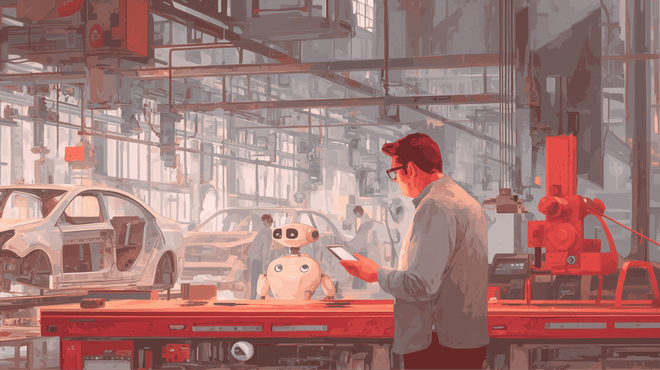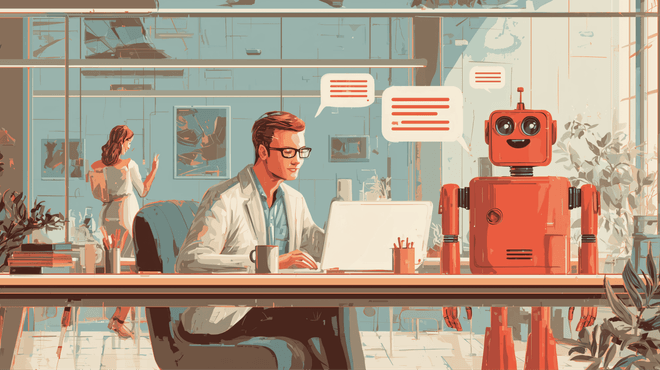This article will get you ready for AI consulting. You’ll know all the basics, and will be on the same page with the consultants.
Everything you need to know before hiring an AI consulting company – in one guide.
Part 1: AI basics
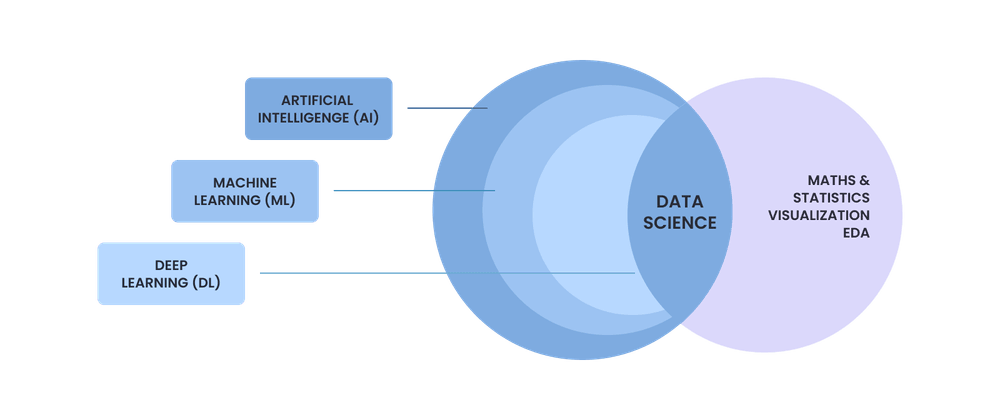
We are in the middle of the AI boom. AI has been gaining traction for years, but today even my grandmother heard about it.
Still, AI seems mysterious because it’s full of buzzwords: machine learning, deep learning, data science, data engineering, etc. Let’s break them down one by one.
Artificial intelligence (AI)
Artificial intelligence (AI) is a technology that simulates humans. So, AI systems do what people do: they learn, see, write, solve problems, and make predictions.
But today, all AI is narrow AI. It performs a small number of tasks extremely well, but when it comes to new tasks it’s absolutely clueless. A chess model called Stockfish can beat any grandmaster, but it can’t order a cup of coffee.
The models become wider over time. When ChatGPT was released, it only supported text input – you couldn’t speak with it. With GPT-4, you could upload images. Now, GPT-4o can talk to you with a silky voice that sounds just like Scarlett Johannson. It can interpret your conversations in real time or tutor your kids in math.
Still, none of the current models have consciousness, self-awareness, or cognition. Today, AI is a tool that doesn’t fully replace experts at their jobs. You still need someone to write prompts or verify the results.
Confused by AI jargon? Basics of AI, data science, machine learning, deep learning, and generative AI – explained as simply as counting on your fingers. Read the article.
Machine learning (ML)
Machine learning (ML) is a subset of AI that relies on adaptive learning, with no explicit programming. So ML engineers don’t pre-program answers for every single input. The model figures out responses on its own.
By contrast, non-ML AI models are rigid and rule-based. Email filters are usually non-ML. If the email has keywords like ‘prize’ or ‘free’, then it’s automatically marked as spam.
Most modern AI systems apply at least some elements of machine learning. That’s why the terms are often used interchangeably. But you can still find non-ML AI models in fields like robotics, speech, or image recognition.
Need a machine learning solution?
Find out how machine learning can skyrocket your workflow. Start with a free consultation.
Deep learning (DL)
Deep learning (DL) is a subset of ML that uses neural networks. A neural network works just like our brains. Our brains are made out of neurons, and every neuron is linked with thousands of other neurons. AI neural networks work the same way:
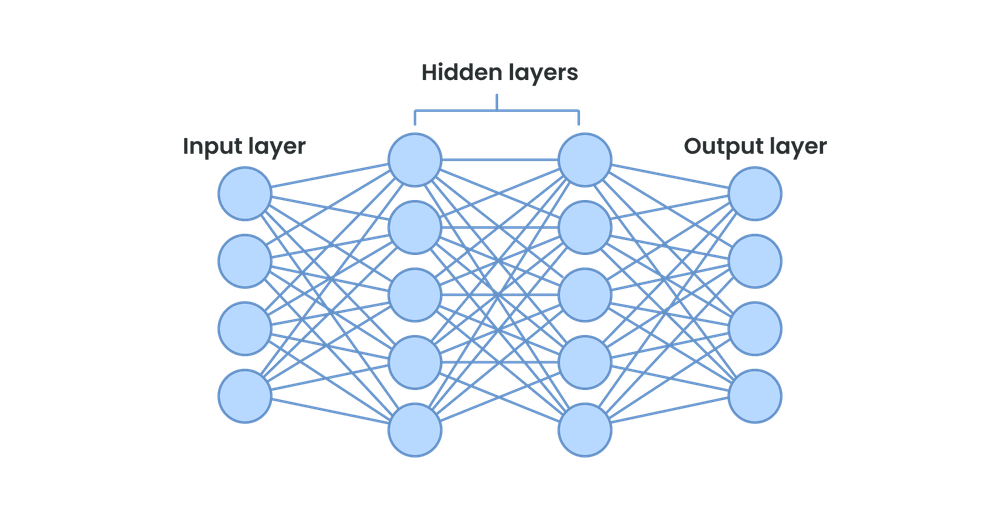
To train the model, developers upload real-world input and output data. The AI will try to find connections between input and output. They are called the hidden layers. At first, the hidden layers are random and can be incorrect. However, after each step of training, the connections become more accurate.
Let’s say, you want to create a neural network that predicts exam grades.
- First, you need a random hypothesis: to analyze attendance equal perfect test scores?
- Test the hypothesis. You train the model on real-world data, but only on student grades and attendance scores. Once the model is trained, you feed slip-up attendance scores of some students and let it predict their grades.
- Adjust. The model checks how accurate the initial predictions DaVinci the model is inaccurate, the model adjusts its parameters through a process called backpropagation.
- Iterate. The adjusted model runs the tests again. This process can take hundreds and even thousands of iterations until the developers are satisfied with the accuracy.
The more diverse your input data, the more accurate the results. To estimate exam scores, you may need to collect more than just attendance. It could be student grade history or time spent on finishing homework.
Wondering how machine learning differs from deep learning? Our detailed explanation breaks it all down for you. Learn more.
Data science (DS)
Data science (DS) is at the crossroads of AI and statistics. Its goal is to extract knowledge from data.
Not all AI is data science, but there’s a huge overlap. When it’s used to gain insights, it’s data science. So, all predictive analytics and recommendation systems are data science. But much of AI isn’t data science: generative AI, speech recognition, natural language processing (NLP), robotics, etc.
The neural network example that predicts grades is also data science.
Data engineering
Data engineering is about the infrastructure for data science. Data engineers build systems that collect, store, and process data. When the data pipeline works smoothly, data scientists extract insights from it.
So while data scientists focus on data insights, data engineers create pipelines to make it all happen.
Types of AI algorithms
There are plenty of different algorithms, but we’ll focus on the major types.

Supervised learning models
Supervised learning models learn by example. To train the model, developers feed it with extensive input and output data. As the AI identifies patterns, it can predict outcomes for new data.
There are two main types of supervised models:
- Regression models find connections between variables. You can visualize such connections in a chart with X and Y axes, as in the picture above. If a coffee shop sells a cappuccino for $5, you can calculate the price of 10 cups. That’s called linear regression.
- Classification models sort items into categories. Imagine a full fruit bowl. If I ask you to pick all the bananas out, you’ll instinctively look at the shape, color, and so on. To people, classification is simple and automatic. We don’t need to have seen a billion bananas to tell them apart. But computers need a ton of input, and that’s why we still have captchas (although bots have become better at it).
Supervised models are great when you have lots of labeled data. They are perfect for content recommendation systems, automated grading, and language learning tools.
Unsupervised learning models
Unsupervised learning doesn’t have human guidance. Developers feed AI with large datasets and let it find patterns on its own.
Clustering is a popular type of unsupervised learning. It’s similar to classification, except the data is unlabeled.
Let’s say I ask you to separate some gemstones by type. Even if you have never seen a gemstone, I bet you can tell rubies and emeralds apart. All because they look completely different: one’s reddish, the other is greenish.
Use unsupervised learning when you need to identify trends, organize content, or cluster students.
Semi-supervised learning
Semi-supervised learning is like having a smart assistant with partial instructions. It combines labeled and unlabeled data to learn. For instance, if you label a few pictures of apples and bananas and leave the rest unlabeled, the algorithm uses the labeled data to classify the rest.
This method works well when labeling data is time-consuming or expensive but you still want accurate results.
Reinforcement learning models
Reinforcement learning models are trained with feedback.
The algorithm interacts with the environment, and receives feedback – either rewards or penalties. The AI learns to maximize actions for long-term rewards.
Back to the gemstone example. Imagine that you need to pick all rubies out of 10 stones, but you don’t know what it looks like. If you pick the right gem, you can keep it. If you make a wrong choice, you’ll get hit with a stick. That’s reinforcement learning.
Use reinforcement learning models when you have a dynamic environment. With such models, you can simulate physics experiments, create adaptive learning paths, or power your interactive learning games.
Part 2: How to apply AI
AI can be applied to virtually any industry, transforming workflows and decision-making processes. Most often, when we talk about AI today, we mean generative AI – the most popular and impactful technology in the field. It complements traditional AI by creating content like text, images, or even music.
Generative AI vs discriminative AI
If you want to use AI, you need to know the difference between generative and discriminative AI.
The basics are pretty simple: generative AI generates new data, while discriminative models classify data sets into different groups.
So, a generative AI will make a picture of a banana. A discriminative AI can tell bananas apart from apples.
Here’s how to tell if you have generative or discriminative AI. It is Gen AI when the output is content – like text, audio, image, video, or any combination of those. It’s not generative if the output is mathematical: a probability, a number, or a classification (apples or bananas?).
Learn more about generative AI in our guide. Find out how the world's best educators use AI in real life.
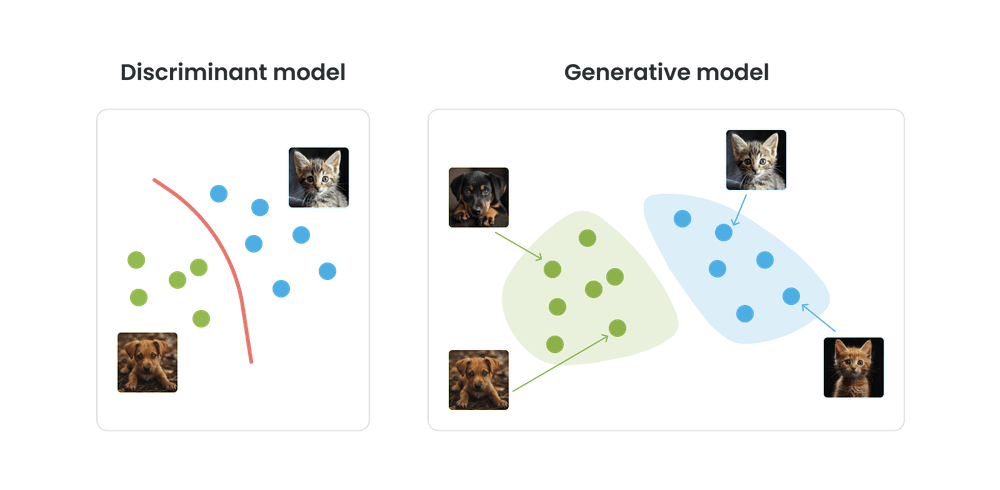
Popular AI solutions
AI chatbot
Chatbots generate responses, so they have to be generative – right? Well, no. Chatbots rely on both generative and discriminative models.
In fact, the first chatbots were not even AI-based. They just searched for keywords in your prompt and outputted a pre-written response. That’s also how search engines work at their core.
Most chatbots today are either discriminative or generative. They use machine learning algorithms to find out your intent and will respond based on context. Others say you want to order pizza with a chatbot and type “I want some pizza today”
- A non-AI chatbot will see the “pizza keyword” and list their pizza toppings: cheese, meat, or pepperoni. But if you tell the chatbot that you don’t like their pizza and want something else – the chatbot will still list pizza options. All because it doesn’t understand context, it just sees the “pizza” prioritized and assumes that you want pizza.
- A discriminative AI chatbot will understand the context. With it, your prompt can be more abstract: “I want a pizza for 4 people with some tropical toppings”. And it will suggest an extra large pizza with pineapple.
- A gen AI chatbot feels more natural. The output is not just a list of suggestions. A modern generative AI chatbot can hold up a conversation, so it’ll feel like talking to a very pizza-smart person, not just a bot.
Real-life example
We built a gen AI chatbot that automates customer support for an elearning platform.
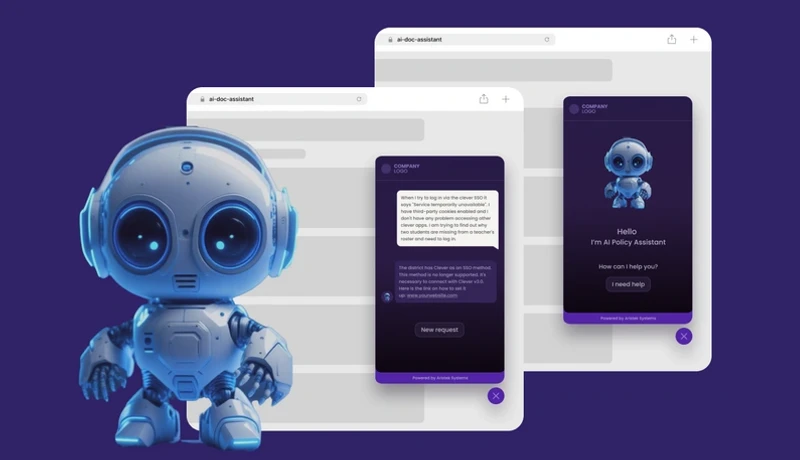
Part 3: AI in different industries
Education
Optimize administrative tasks. Administrative work is a huge part of education, but in most schools, it’s not optimized. Here’s where AI can help:
- Scheduling;
- Classroom and locker layouts;
- Staff allocation;
- Enrollment;
- Routing guidance.
This is just the tip of the AI-in-education iceberg
The scope of the technology is much wider than at first glance. Want to know what challenges AI can tackle for your business?
Now let’s take a look at the most widely cited advantages of AI in education, as noted by both administrators and faculty.
Automatic student grading. Checking assignments is a huge part of teachers’ work. And since there is a teacher shortage in the US, it’s good to relieve them from this burden.
AI can free up educators for more interesting tasks. Sure, some assessments will still require teachers’ attention. But AI can find these situations, too.
Now, AI has a downside – students use it for exams and homework. Thankfully, there are AI content detectors. Of course, these are AI-based too.
Course analytics. Most curriculum publishers don’t have a full picture of student engagement. Without AI, publishers rely on very basic tools: they can check grades or ask students if they’ve enjoyed the course.
AI takes this to the next level. With good analytics, EdTech companies understand exactly which parts of the course to improve. For example, they’ll see when the students pause or skip videos.
AI assistants. AI makes private tutoring accessible to any world-class dentist who can have a tutor available 24/7, at a fraction of the cost.
But it’s an unexpected advantage, too. With AI assistants, no student will hold back their questions because it seem basic or foolish. Students can ask anything without judgment or peer pressure.
Take a look at how GPT-4o helps solve a math problem.
Content personalization. AI doesn’t just personalize. It hyper-personalizes. That means adapting content, timing, channels, and even tones of communication based on individual behavior and preferences. Whether it’s product recommendations or training paths, AI helps deliver the right message to the right person – automatically.
We explored what hyper-personalization really means and how it works in our article.
Want to know more about AI in education?
Learn how to improve corporate and e-learning education by introducing the right type of AI
Corporate training
AI is entering every corner of education – and corporate learning is one of the fastest-growing areas.
A 2024 McKinsey report found that 72% of businesses already use AI in at least one area of their operations. Among large enterprises, 42% have it embedded into their workflows, and another 40% are actively exploring ways to apply it.
Learning and Development (L&D) teams aren’t standing still. According to recent data, 60% of L&D teams now use generative AI for key tasks such as:
- Creating and updating training content
- Providing on-demand assistance to employees
- Mapping skill gaps and recommending personalized learning paths
So why is AI catching on so quickly in corporate training? Because business environments change fast – and traditional training methods often lag behind. AI helps teams stay current, efficient, and relevant.
Here are three common use cases:
- Auto-generating training content
Instead of manually creating long training manuals or slide decks, L&D teams can use AI to generate outlines, lesson plans, or even full modules. Updates are faster, and training stays aligned with business needs. - Virtual coaches and performance support
AI-powered assistants can offer employees tips, explain policies, or guide them through systems – right when they need help. This supports learning in the flow of work, without pulling people away for a full session. - Skills assessment and reskilling paths
AI tools can analyze employee performance data to identify skill gaps, suggest training priorities, and recommend tailored development plans – especially useful during internal mobility or digital transformation.
We integrated an AI-driven chatbot into an educational platform to enhance student learning.
The solution automates inquiries, delivers personalized support, and ensures seamless integration with existing systems.

Companies are learning that training doesn’t have to be reactive. With AI, it becomes smarter, faster, and more aligned with business goals.
Explore the full article to learn:
- What businesses think about AI in L&D
- What’s holding some companies back
- How AI contributes to effective and scalable corporate training.
Corporate training doesn’t have to be boring
Or slow. Or forgotten two days later. We create practical, engaging software that teams want to use – and businesses see results from.
Healthcare
Patient engagement. AI chatbots like Ada are pretty good at patient recommendations. They integrate with smartwatches and other wearable devices to analyze your health in-depth.
But let’s keep in mind that such chatbots do not diagnose differences. They are not responsible for your treatment, unlike real doctors. But they are a great tool, even for the doctor use.
Surgeries. People are not as stable as robots. We breathe, and we have heart rate. Sometimes these facts alone lead to a disaster. In surgery, one slip-up can cost a life.
That’s why the first surgical robots in the US were approved long ago, in the year 2000. Surgical systems like the DaVinci absorbs natural body movements, saving thousands of lives. Yet they leave control to surgeons, who still make all the important decisions.
Smart health monitoring. AI-powered wearable devices and sensors continuously track vital signs like heart rate, blood pressure, and glucose levels. This way, they alert users and healthcare providers to any abnormalities for early intervention.
Diagnosis and treatment. AI algorithms analyze medical images, like X-rays and MRIs. Sometimes a doctor doesn’t see a problem, but AI can find even the smallest patterns that indicate cancer.
Administrative applications. AI automates administrative tasks. This minimizes paperwork and secures patient data. Here are some things that AI automates:
-
- Appointment scheduling;
- Electronic health record (EHR) management;
- Insurance claim processing.
Drug discovery. Some say that we are on the brink of a major breakthrough in molecule design, but others are more skeptical.
Still, the recent announcements by DeepMind and AlphaFold pave the way for better understanding of disease processes, predicting protein structures, and developing more targeted therapeutics.
AI tools on multimodal datasets could enhance disease understanding and clustering, as well as patient population clustering.
This will be revolutionary for multiple standards of care, with particular impact in the cancer, neurological, and rare disease spaces.
Learn more about AI in healthcare?
Read our guide to learn how healthcare companies improve their workflow, cut costs, and save lives.
AI in veterinary
Like in healthcare, AI is also a big helper in the veterinary business. And the numbers prove this:
Here are the key areas where AI is making an impact:
- Imaging & administrative efficiency
AI speeds up X-ray and ultrasound analysis, spotting abnormalities with fewer errors. It also automates scheduling, billing, and client communication, freeing up staff for patient care.
Learn how EHR systems boost administrative efficiency.
- Voice-to-text for faster records
AI transcribes vets’ spoken notes into digital records, cutting paperwork time and improving accuracy even during busy shifts.
- Smarter diagnosis & early detection
AI cross-references symptoms, lab results, and past cases to support vets in detecting diseases sooner. It’s a reliable second opinion, not a replacement.
Learn how we developed an AI solution for the veterinary business.
Our solution automates patient intake, symptom assessment, and appointment scheduling, ensuring pets receive timely and appropriate care. The results:
- 50% reduction in front-desk workload
- 30% faster check-in
- 20% improvement in appointment utilization

Business
Improve customer experience. A chatbot is probably the first thing that comes to mind when thinking of customer experience. And that’s true, they allow 24/7 access to support which can be vital.
But there’s also behavior analysis. AI can analyze customer interactions across many channels. You can predict churn early on and offer clients personalized offers. You can also identify customer feedback and identify paint points.
This helps businesses to better understand customer needs and offer tailored recommendations. So not only do customers get happier, but also you get to improve your sales.
Real-life example
We built an AI analytics tool for a retail giant. It analyzes customer behavior and uses that data to forecast sales. So, you can make customers happy and skyrocket your analytics with 1 tool.
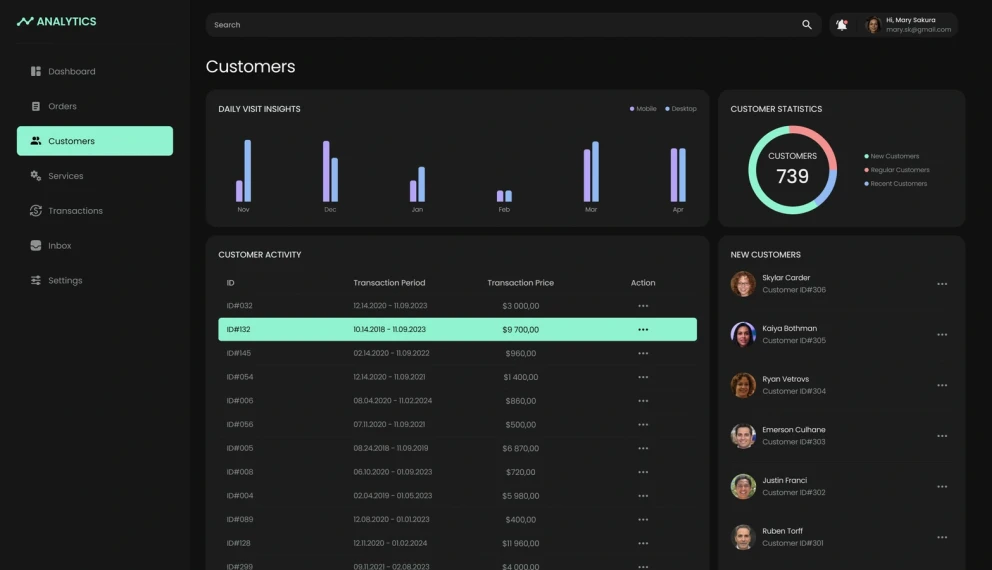
Solve uncodable tasks. There are some tasks that traditional programming won’t handle, either because it’s too expensive or simply not possible.
The most obvious examples are natural language processing or image recognition. Both are applicable for AI only.
Other tasks are possible even with regular programming, but it wouldn’t be optimal. Think of dynamic pricing, fraud detection, or inventory management. All of them can be solved old-school way. But in all 3 cases, you get better results with AI and the development can even end up cheaper.
Automate tedious work. Who likes to fill out Excel spreadsheets? Much of our daily tasks are plain and boring. AI can take care of that, letting you focus on challenging work instead. It’s a win-win for both the business and the employee because some things are better left for the computer.
This process is called RPA or Robotic Process Automation. RPA automates repetitive tasks traditionally done by people. Robots or bots mimic humans in digital systems to handle monotonous tasks like data entry, form processing, and report generation.
Learn how to implement AI in business, step by step. From understanding your requirements to tracking AI performance
7 steps of AI development in business
How is AI reshaping industries like manufacturing, finance, entertainment, and sports? Read our article to learn more and get inspired for your future project!
From vision to practice – how AI supports daily work
We’ve already seen how AI is reshaping industries. But its impact doesn’t stop there. Beyond grand strategies and digital transformation plans, AI is steadily changing how teams work every day.
Let’s explore how AI tools and techniques are helping professionals solve real tasks, automate repetitive work, and focus on what matters.
AI in software development
AI isn’t writing full applications (yet), but it’s becoming a reliable sidekick for developers. It helps speed up code generation, troubleshoot bugs, and even explain unfamiliar codebases.
ChatGPT is among the most widely adopted tools in this space. It assists both junior and senior developers alike with the tasks ranging from writing snippets and documentation to automating test cases.
Read the full article to know how ChatGPT is becoming the developer’s new best friend.
Alongside ChatGPT, tools like DeepSeek are entering the spotlight. DeepSeek made waves for its promising results and surprisingly strong performance – especially considering its recent release. We broke down what makes it different, how it performs, and what to watch out for.
Discover more about DeepSeek and its potential.
AI in cybersecurity
AI is helping security teams detect and respond to threats faster than ever. It scans large volumes of logs, flags anomalies, and even predicts potential vulnerabilities based on behavior patterns.
From phishing detection to real-time monitoring, it’s become a vital tool for overburdened cybersecurity teams. We explored the specific use cases and tools that make it effective – and where human oversight is still needed.
AI and AIOps
Modern IT environments are too complex to manage manually. This is where AIOps (Artificial Intelligence for IT Operations) is becoming more popular. It helps teams prevent incidents, reduce downtime, and improve system reliability by analyzing metrics, logs, and traces in real time.
The technology is already used in large-scale operations to cut through noise and highlight what really needs attention.
Curious how it works and when it makes sense to adopt? Here’s our explainer.
AI for document processing
Another powerful (and often overlooked) application of AI is in document automation. AI can extract key information from invoices, contracts, and forms, saving hours of manual work – especially in industries like healthcare, logistics, and finance.
It doesn’t just scan PDFs – it understands content, classifies documents, and fills data into the right systems. This improves accuracy and helps employees focus on value-added tasks.
Part 4: How to get an AI
How to choose the AI consulting company
Company or person? We recommend going for an AI company.
One person might be great at training AI models, but terrible at fitting the model into your business needs. You may get a technically sound AI that doesn’t bring any actual value. That’s why even the most experienced AI developers can be poor consultants. With a company, you hire both technical and business people at once.
Also, when you hire a company, you get collective experience of the entire organisation. No matter how much experience a single consultant will have, a good AI company will always have more.
Get a free AI consultation
Thinking of introducing AI? We’ll make sure that your solution brings maximum value. Let’s see how AI can improve your workflow.
How to develop an AI PoC
A PoC, or Proof of Concept, is a demonstration to show that a concept or idea is feasible. It’s a way to test whether a proposed solution will work in real-world conditions before investing more time and resources into full development.
You develop a PoC the same way you build an AI model. Here’s how:
Define the objective. Find out exactly how AI can help your company. To do that, clearly state the problem you want to solve and identify the key metrics for success.
Gather and prepare data. Most likely, your company already has a ton of data. It’s time to organize it. Clean, preprocess, and annotate the data to improve its quality.
Select your AI approach. Choose the right algorithms for the problem. Is it machine learning, deep learning, natural language processing or something else? Decide on the tools and frameworks. It could be TensorFlow, PyTorch, Scikit-learn, etc.
Build the model. Develop a prototype of the AI model. Train the model using the prepared data, and fine-tune hyperparameters.
Test and evaluate. Feed the model with real-world data and see if the predictions are correct.
Iterate and improve. The first iterations are far from accurate. Refine the model based on feedback and your test results. Train the model and test it until your are happy with the results. But remember your starting goal and don’t drag the iteration process into infinity. After all, it’s only PoC
Gather feedback. Discuss the model with the developers and your stakeholders. See if it makes sense to implement full scale model. If so, then what are the potthe ential challenges and next steps?
Plan for scaling. Finally, get a plan for full-scale implementation. Consider your resources, infrastructure, and any additional data that’s required for scaling up.
Top AI and data science companies
Let me be clear: we are an AI and data science development company. A very good one, actually.
But many others companies are great at working with AI, too. It’s not about finding the best AI company. It’s about finding the best AI company for you.
Here are the main criteria to look out for:
Location. Check if the vendor matches your working hours. Even if you hire an offshore company, they typically still provide some overlapping hours for communication.
Price. Pricing is important, but priorities the value that your AI vendor brings. You get what you pay for. Cheap companies have fewer experts, less experience, and they focus on smaller projects. Sometimes (though, not always) cheaper companies have a poor working culture: there’s a higher chance of missed deadlines or just less overall value
Type of data science services. Data science is vast. From a small business sales forecast to e-commerce customer behavior analysis. Small companies usually focus on smaller projects.
We’ve talked enough about us. Read about other data science companies in our list
Top 10 data science consulting companies
Part 5: The state of AI
AI compliance
We don’t have global AI regulations, yet. But this is about to change.
EU Artificial Intelligence Act. It’s not active yet, but will be sometime in 2024. The EU AU act will the the trendsetter, just like GDPR was in terms of privacy. The act will sort all AI into 4 categories based on their risk: from unaccepted to minimum-risk solutions. Unethical applications like social scoring systems are world-class in the EU. Non-compliant companies will have to pay giant fines, up to €36 million or 7% of yearly turnover, whichever is higher
GDPR and international privacy regulation. AI solutions must be especially careful about privacy. AI companies face the question: are they controllers or processors? Sometimes, it’s hard to know from the start.
US regulations. There’s no federal AI regulation in the US. Some bills are passed, but far from getting implemented. In the meantime, companies have to follow local laws, like NYC law 144 or Connecticut SB1103
AI regulation is hard. But we cover current state of it in our guide. Learn everything you need to know in 2024
Breakdown of AI compliance in 2024
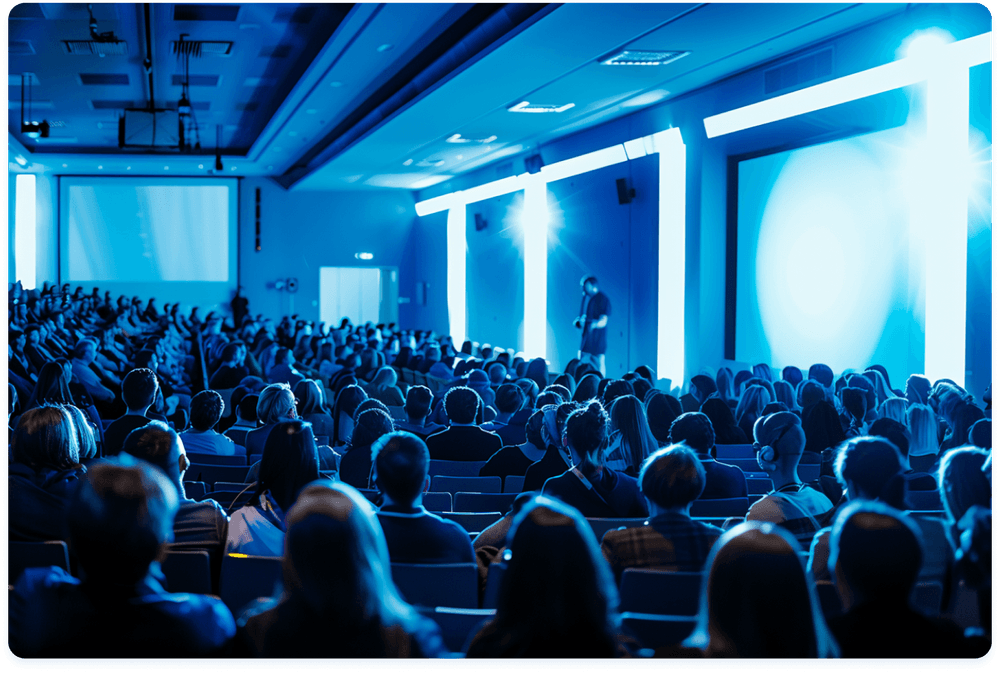
The future of AI
Scientific discovery
Our society faces many challenges, and AI can help solve them.
- To tackle climate change, AI will create sustainable agriculture. Agrotech AI models use satellite images to analyze soil, weather, and crop conditions. They analyze all the data to increase yields and reduce resource use.
- In astrophysics, AI analyzes telescope images to find new exoplanets or gravitational waves.
- In neuroscience, researchers from Google and Harvard have just created a very detailed brain map. Though it’s not a map of the entire brain yet, with this knowledge scientists can already create advanced brain-machine interfaces
- In physics, AI is used to research nuclear fusion. There’s hope that we’ll be able to fuse atoms together – just like Sun does. If that happens, we’ll have a virtually endless source of energy.
And this list goes on. We might be getting into a new renaissance thanks to AI.
Small language models instead of LLM
A groundbreaking computer from 1945 took up an entire room and operated at 100kHz. An iPhone 15 fits in your palm and operates at 3.5GHz – that’s almost 35000 times more powerful.
The same thing is happening with AI. For example, GPT-4 runs 100 trillion parameters (100 000 000 000 000). But soon, small language models can take over. They will only need a few billion parameters – enough to run on your phone.
Today we still have giant supercomputers, but they are not for daily use. Supercomputers design molecules, research nuclear fusion – and power LLMs. Soon, we will use smaller models for simple tasks and leave LLM for the most advanced research.
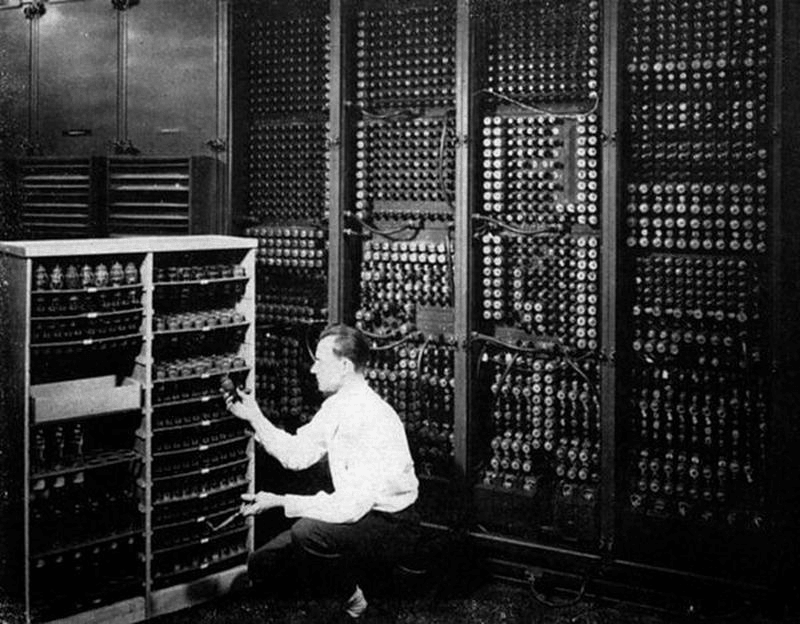
Multimodal AI
We’ve already discussed that all current AI is narrow. Any specific model can only perform so many tasks. A model that can perform complicated customer behavior analysis, can’t have a small talk with your customer. And vice versa: an AI chatbot can chatter with your clients, but can’t analyze their behavior.
But AI gets multimodal. GPT 4o combines audio, text, and vision. It can talk, generate images and 3D models, and much more. Soon, multimodal AI might can the new standard.
AI is the future
Learn more about current AI and ML trends in our article. What’s next?
Now you’re ready for AI consulting. You should know all the basics, so there should be no problem talking to the AI consultants.
Bonus. Looking for a consulting company? Here we are. We consult companies on getting the right solution, and we build AI models from scratch. Reach out for a free consultation.


